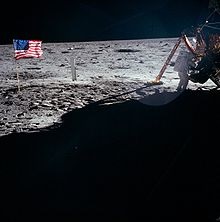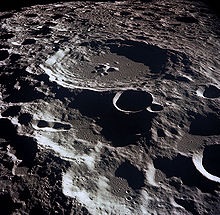|
|
| |
|
|
| |
|
|
|
|
| |
 |
| Full moon seen from
Earth. |
Moon
The Moon is Earth's satellite, and we can usually see it
in the night sky. Other planets also have moons or
"natural satellites". The Moon is thought to have formed
about 4.51 billion years ago, not long after Earth. The
most widely accepted explanation is that the Moon formed
from the debris left over after a giant impact between
Earth and a Mars-sized body called Theia.
The Moon is just under 3,500 kilometres (2,200 mi) wide.
That's over a quarter of the size of the Earth (about
12,600 kilometres (7,800 mi) wide). Because of this, the
Earth and Moon together are sometimes called a binary or
double planet system.
Phases
The Moon being round, half of it is lit up by the sun.
As it goes around (or orbits) the Earth, sometimes the
side that people on Earth can see is all lit brightly.
Other times only a small part of the side we see is lit.
This is because the Moon does not send out its own
light. People only see the parts that are being lit by
sunlight. These different stages are called Phases of
the Moon.
It takes the Moon about 29.53 days (29 days, 12 hours,
44 minutes) to complete the cycle, from big and bright
to small and dim and back to big and bright. The phase
when the Moon passes between the Earth and Sun is called
the new moon. The next phase of the moon is called the
"waxing crescent", followed by the "first quarter",
"waxing gibbous", then to a full moon. A full Moon
occurs when the moon and sun are on opposite sides of
the Earth. As the Moon continues its orbit it becomes a
"waning gibbous", "third quarter", "waning crescent",
and finally back to a new moon. People used the moon to
measure time. A month is approximately equal in time to
a lunar cycle.
The moon always shows the same side to Earth.
Astronomers call this phenomenon tidal locking. This
means that half of it can never be seen from Earth. The
side facing away from Earth is called the far side or
dark side of the Moon even though the sun does shine on
it—we just never see it lit. |
|
 |
| Neil Armstrong
working at the Lunar Module Eagle during Apollo
11 (1969). |
History of exploring the
Moon
Before people stood on the Moon, the United States and
the USSR sent robots to the Moon. These robots would
orbit the Moon or land on its surface. The robots were
the first man-made objects to touch the Moon.
Humans finally landed on the Moon on July 21, 1969.
Astronauts Neil Armstrong and Buzz Aldrin landed their
lunar ship (the Eagle) on the surface of the moon. Then,
as half the world watched him on television, Armstrong
climbed down the ladder of the Eagle and was the first
human to touch the Moon as he said, "That's one small
step for a man, one giant leap for mankind."
Even though their footprints were left on the moon a
long time ago, it is likely that they are still there,
as there is no wind or rain, making erosion extremely
slow. The footprints do not get filled in or smoothed
out.
More people landed on the moon between 1969 and 1972,
when the last spaceship, Apollo 17 visited. Eugene
Cernan of Apollo 17 was the last person to touch the
moon. |
|
 |
| Lunar crater
Daedalus on the Moon's far side |
Characteristics
Because it is smaller, the Moon has less gravity than
Earth (only 1/6 of the amount on Earth). So if a person
weighs 120 kg on Earth, the person would only weigh 20
kg on the moon. But even though the Moon's gravity is
weaker than the Earth's gravity, it is still there. If
person dropped a ball while standing on the moon, it
would still fall down. However, it would fall much more
slowly. A person who jumped as high as possible on the
moon would jump higher than on Earth, but still fall
back to the ground. Because the Moon has no atmosphere,
there is no air resistance, so a feather will fall as
fast as a hammer.
Without an atmosphere, the environment is not protected
from heat or cold. Astronauts wore spacesuits, and
carried oxygen to breathe. The suit weighed about as
much as the astronaut. The Moon's gravity is weak, so it
was not as heavy as on Earth.
In the Earth, the sky is blue because the blue rays of
the sun bounce off the gases in the atmosphere, making
it look like blue light is coming from the sky. But on
the moon, because there is no atmosphere, the sky looks
black, even in the daytime. There is no atmosphere to
protect the moon from the rocks that fall from outer
space, and these meteorites crash right into the moon
and make wide, shallow holes called craters. The moon
has thousands of them. Newer craters gradually wear away
the older ones.
A blue moon is an additional full moon that appears in a
subdivision of a year: either the third of four full
moons in a season, or a second full moon in a month of
the common calendar.
Origin of the Moon
The giant impact hypothesis is that the Moon was created
out of the debris from a collision between the young
Earth and a Mars-sized protoplanet. This is the favored
scientific hypothesis for the formation of the Moon.
Water on the Moon
In 2009 NASA said that they had found a lot of water on
the moon. The water is not liquid but is in the form of
hydrates and hydroxides. Liquid water cannot exist on
the Moon because photodissociation quickly breaks down
the molecules. However, from the image NASA received,
there is a history of water existence. |
|
Legal status
During the Cold War, the United States Army thought
about making a military post on the Moon, able to attack
targets on Earth. They also considered conducting a
nuclear weapon test on the Moon. The United States Air
Force had similar plans. However, both plans were
brushed-off as NASA moved from a military to a
civilian-based agency.
Even though the Soviet Union left remains on the Moon,
and the United States left a few flags, no country has
control over the Moon. The U.S. and Soviet Union both
signed the Outer Space Treaty, which calls the Moon and
all of outer space the "province of all mankind". This
treaty also banned all use of the military of the Moon,
including nuclear weapons tests and military bases.
United States missions
Following President John F. Kennedy's 1961 commitment to
a manned moon landing before the end of the decade, the
United States, under NASA leadership, launched a series
of unmanned probes to develop an understanding of the
lunar surface in preparation for manned missions.
The manned Apollo program was developed in parallel;
after a series of unmanned and manned tests of the
Apollo spacecraft in Earth orbit, and spurred on by a
potential Soviet lunar flight, in 1968 Apollo 8 made the
first manned mission to lunar orbit. The subsequent
landing of the first humans on the Moon in 1969 is seen
by many as the highest point of the Space Race.
Neil Armstrong became the first person to walk on the
Moon as the commander of the American mission Apollo 11
by first setting foot on the Moon at 02:56 UTC on 21
July 1969. An estimated 500 million people worldwide
watched the transmission by the Apollo TV camera, the
largest television audience for a live broadcast at that
time.
The Apollo missions 11 to 17 (except Apollo 13) returned
380.05 kilograms (837.87 lb) of lunar rock and soil in
2,196 separate samples. The American Moon landing and
return was enabled by considerable technological
advances in the early 1960s, in domains such as ablation
chemistry, software engineering, and atmospheric
re-entry technology, and by highly competent management
of the enormous technical undertaking.
Scientific instrument packages were installed on the
lunar surface during all the Apollo landings. Long-lived
instrument stations, including heat flow probes,
seismometers, and magnetometers, were installed at the
Apollo 12, 14, 15, 16, and 17 landing sites. Direct
transmission of data to Earth concluded in late 1977
because of budgetary considerations.
Other missions
After the first Moon race there were years of near
quietude but starting in the 1990s, many more countries
have become involved in direct exploration of the Moon.
In 1990, Japan became the third country to place a
spacecraft into lunar orbit with its Hiten spacecraft.
The spacecraft released a smaller probe, Hagoromo, in
lunar orbit, but the transmitter failed, preventing
further scientific use of the mission.
In 1994, the U.S. sent the joint Defense Department/NASA
spacecraft Clementine to lunar orbit. This mission
obtained the first near-global topographic map of the
Moon, and the first global multispectral images of the
lunar surface. This was followed in 1998 by the Lunar
Prospector mission, whose instruments indicated the
presence of excess hydrogen at the lunar poles, which is
likely to have been caused by the presence of water ice
in the upper few meters of the regolith within
permanently shadowed craters.
India, Japan, China, the United States, and the European
Space Agency each sent lunar orbiters, and especially
ISRO's Chandrayaan-1 has contributed to confirming the
discovery of lunar water ice in permanently shadowed
craters at the poles and bound into the lunar regolith.
The European spacecraft SMART-1, the second
ion-propelled spacecraft, was in lunar orbit from 15
November 2004 until its lunar impact on 3 September
2006, and made the first detailed survey of chemical
elements on the lunar surface.
The post-Apollo era has also seen two rover missions:
the final Soviet Lunokhod mission in 1973, and China's
ongoing Chang'e 3 mission, which deployed its Yutu rover
on 14 December 2013. China intends to launch another
rover mission (Chang'e 4) before 2020. The Moon remains,
under the Outer Space Treaty, free to all nations to
explore for peaceful purposes.
On 28 February 2018, SpaceX, Vodafone, Nokia and Audi
announced a collaboration to install a 4G wireless
communication network on the Moon, with the aim of
streaming live footage on the surface to Earth.
Legal status
Although Luna landers scattered pennants of the Soviet
Union on the Moon, and U.S. flags were symbolically
planted at their landing sites by the Apollo astronauts,
no nation claims ownership of any part of the Moon's
surface. Russia, China, and the U.S. are party to the
1967 Outer Space Treaty, which defines the Moon and all
outer space as the "province of all mankind".
This treaty also restricts the use of the Moon to
peaceful purposes, explicitly banning military
installations and weapons of mass destruction. The 1979
Moon Agreement was created to restrict the exploitation
of the Moon's resources by any single nation, but as of
November 2016, it has been signed and ratified by only
18 nations, none of which engages in self-launched human
space exploration or has plans to do so. Although
several individuals have made claims to the Moon in
whole or in part, none of these are considered credible. |
|
 Kiddle:
Moon Kiddle:
Moon
Wikipedia: Moon |
|
|
|
|
|
|
|
|
|
|
|
|
|
|
|
|
Search Fun Easy English |
|
|
|
|
|
|
|
|
|
|
|
|
|
|
|
About
Contact
Copyright
Resources
Site Map |